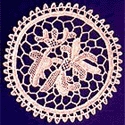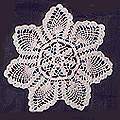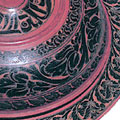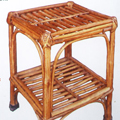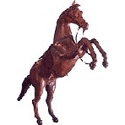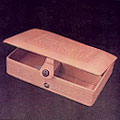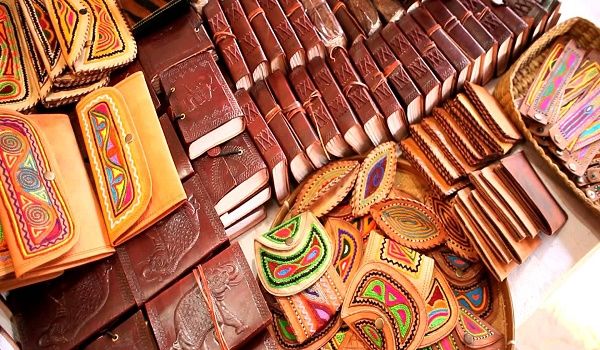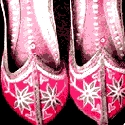Lace and Crochet Embroidery of Uttar Pradesh,
This is a traditional craft and has been practised in India for the last 300 to 400 years. Chetipani is the simplest kind of crochet and is usually made by the beginners. The other kind is Athakupani or joint attachment, in which different kinds of flower designs are combined to form the pattern. The combinations are harmonious and require a lot of imagination and dexterity. The designs are inspired from floral, nosegay, almond, and date motifs. The colours used commonly are black and brown with white and ikat weaves. The products dominantly comprise items for household use: curtains, bedspreads, and furniture covers. Dress materials often have crochet pieces as borders. Large pieces of crochet are preferred in the export market. In Tamil Nadu a variety of exquisite cotton and silk lace is being made.
This is a traditional craft and has been practised in India for the last 300 to 400 years. Chetipani is the simplest kind of crochet and is usually made by the beginners. The other kind is Athakupani or joint attachment, in which different kinds of flower designs are combined to form the pattern. The combinations are harmonious and require a lot of imagination and dexterity. The designs are inspired from floral, nosegay, almond, and date motifs. The colours used commonly are black and brown with white and ikat weaves. The products dominantly comprise items for household use: curtains, bedspreads, and furniture covers. Dress materials often have crochet pieces as borders. Large pieces of crochet are preferred in the export market. In Tamil Nadu a variety of exquisite cotton and silk lace is being made.
Lace and Crochet Embroidery of Uttarakhand,
This is a traditional craft and has been practised in India for the last 300 to 400 years. Chetipani is the simplest kind of crochet and is usually made by the beginners. The other kind is Athakupani or joint attachment, in which different kinds of flower designs are combined to form the pattern. The combinations are harmonious and require a lot of imagination and dexterity. The designs are inspired from floral, nosegay, almond, and date motifs. The colours used commonly are black and brown with white and ikat weaves. The products dominantly comprise items for household use: curtains, bedspreads, and furniture covers. Dress materials often have crochet pieces as borders. Large pieces of crochet are preferred in the export market. In Tamil Nadu a variety of exquisite cotton and silk lace is being made.

This is a traditional craft and has been practised in India for the last 300 to 400 years. Chetipani is the simplest kind of crochet and is usually made by the beginners. The other kind is Athakupani or joint attachment, in which different kinds of flower designs are combined to form the pattern. The combinations are harmonious and require a lot of imagination and dexterity. The designs are inspired from floral, nosegay, almond, and date motifs. The colours used commonly are black and brown with white and ikat weaves. The products dominantly comprise items for household use: curtains, bedspreads, and furniture covers. Dress materials often have crochet pieces as borders. Large pieces of crochet are preferred in the export market. In Tamil Nadu a variety of exquisite cotton and silk lace is being made.


Lace Work of Sri Lanka,
Lace work is mainly found in the southern parts of the country. This craft was first introduced by the Portuguese in the middle of the sixteenth century and then developed by the Dutch in the middle of the seventeenth century. This craft is practised mainly by women, especially in the areas of Galle, Weligama, Dikwella, Matara, and Hambantota. This thriving craft provides a steady source of employment for young and old. The craft is appreciated and patronised by the locals and by foreign tourists. Along with the introduction of this craft in the southern parts of the country, Western styles of dress and fashion have also become popular. These include the popular kabakurutthu - the Portuguese name for a ladies jacket having lace-work as decoration - which has narrow cuffed sleeves and neckline trimmed with delicate lace, fastened in the front with brooches and buttons. Lace-work is most commonly used to embellish the borders, necklines, and sleeves of ladies' garments.



Lace work is mainly found in the southern parts of the country. This craft was first introduced by the Portuguese in the middle of the sixteenth century and then developed by the Dutch in the middle of the seventeenth century. This craft is practised mainly by women, especially in the areas of Galle, Weligama, Dikwella, Matara, and Hambantota. This thriving craft provides a steady source of employment for young and old. The craft is appreciated and patronised by the locals and by foreign tourists. Along with the introduction of this craft in the southern parts of the country, Western styles of dress and fashion have also become popular. These include the popular kabakurutthu - the Portuguese name for a ladies jacket having lace-work as decoration - which has narrow cuffed sleeves and neckline trimmed with delicate lace, fastened in the front with brooches and buttons. Lace-work is most commonly used to embellish the borders, necklines, and sleeves of ladies' garments.
CRAFT TECHNIQUES & TOOLS
The commonly made lace is the pillow lace or bobbin lace as it is known in some countries. It is an open-work fabric made by intertwining many varieties of fine thread. It is made on a pillow-like structure mounted on a wooden base, raised on short pegs a few inches above the ground. One side of the pillow is about a foot high and the other side is about three inches high, and filled with coir. It is completely covered with a thick cloth nailed to the base all around.
At the centre of the taller end of the pillow is a rectangular compartment twelve inches long, nine inches broad, and nine inches deep. At the centre of this compartment is placed a cylindrical drum that is about six inches in diameter. This is fully covered with cloth wrappings and has a central axel that fits into two grooves at the centre of the two sides of the central compartment. It can be turned around as the work progresses.

At the centre of this drum is a parchment or stiff paper on which is found the perforated outline of the design to be knitted. This paper containing the pattern is known as isbeesalaya; it is wrapped right round the centre of the drum. At the start of the lace-weaving process, the required number of threads are hung in pairs from pins at the top of the drum with bobbins attached to the loose end. These pins are placed in accordance with the pattern on the isbeesalaya. The actual knitting is done by manipulating the bobbins to make the threads cross each other in several ways - such as the twist of two threads, a braid or a plait of four threads, and other complicated combinations. Pins are used to hold the elements of the pattern in place as the work proceeds, while at the same time the drum is turned manually.
The pins in the section where the pattern has been completed are brought forward one by one so that only a limited number of pins are made use of. The tools and equipment needed for this craft include a pillow mounted on a wooden frame, with bobbins or beeralu to carry the thread, the isbeesalaya, and pins. The word 'beeralu' is of Portuguese origin; it is the name given to the wooden bobbin around which the thread is wrapped for making lace on the pillow to which the design is pinned. The term 'renda' - from the Portuguese word 'reinda' - refers to the pattern or 'pillow lace' made on a pillow.
In recent times a new style of making Belgian lace has been introduced in Maligawatta at Colombo and Dikwella in Matara district, where women are obtaining expertise in this type of lace-making at several centres. This new variety of lace-making offers a challenge to the old as a competitive new technique.

TYPES OF LACES
1. Pillow Lace
This is known thus because a stuffed pillow is used as a stand on to which a small stuffed wooden roll is fixed in the middle. The weaving is done by inter-crossing the threads, allowing the design to take shape on the roll.
2. Needlepoint Lace
Needlepoint lace is made on a frame with single and double threads so as to form knots similar to the pattern of rattening of chairs. Teapoy covers, and bedcovers are commonly made in needlepoint lace.
3. Crochet & Tatting
Crochet and tatting techniques have also been introduced and developed in Sri Lanka. They are widely practised by the women artisans in the southern areas of the country. Some of the items made include teapoy covers, bedspreads, blouses, and dresses.

CRAFT LOCATIONS
- Ampara district (on the south-eastern coast of the country): in the village of Gonagolla.
- Colombo district: in the village of Kadawata.
- Galle district (on the southern coast): in the villages of Magalle, Habaraduwa, and Kataluwa.
- Gampaha district (next to Colombo): in the villages of Kadawatta, Mirigama, and Kelaniya.
- Hambantota district (on the southern-most tip of the island-country): in the villages of Ambala, Mirijjawila, Seenimodera, Weeraketiya, Mawella, and Tangalle.
- Kalutara district (on the southwestern coast): in Kalutara town.
- Kurunegala district (near Colombo): in the villages of Udiyawela and Thorayaya.
- Matara district (next to Hambantota district): in the villages of Kudawella, Totamune, Kottegoda, Peekwella, Deeyagaha, Weligama, Issadeen Town, Polwatumodera, Wellawatta, and Demalapitiya.
- Nuwara Eliya district (next to Kandy district, in the central part of the country): in the villages of Pundaluoya, Ramboda, Maskeliya, Rikiligaskada, Kumbaloluwa, Ginigathena, Nuwara Eliya town, and Hatton-Dikoya.
- Ratnapura district: in the village of Pelmadulla.
- Trincomalee district (on the eastern coast): Trincomalee town.
Lacquer-ware,
Lacquer-work is a highly skilled decorative art in which the craftsman first shapes the wood to create the object he wants, using a lathe. Different kinds of wood are used to make boxes, bowls, vases and other turned objects, including chess sets. Traditionally the lathe is hand powered by a cord pulled round a spindle. Several layers of lacquer are applied in different colours and allowed to harden. The design is then incised with sharp tools, exposing the bright colours of the underlying layers.
Lacquer-work is a highly skilled decorative art in which the craftsman first shapes the wood to create the object he wants, using a lathe. Different kinds of wood are used to make boxes, bowls, vases and other turned objects, including chess sets. Traditionally the lathe is hand powered by a cord pulled round a spindle. Several layers of lacquer are applied in different colours and allowed to harden. The design is then incised with sharp tools, exposing the bright colours of the underlying layers.
Lacquer-work is a highly skilled decorative art in which the craftsman first shapes the wood to create the object he wants, using a lathe. Different kinds of wood are used to make boxes, bowls, vases and other turned objects, including chess sets. Traditionally the lathe is hand powered by a cord pulled round a spindle. Several layers of lacquer are applied in different colours and allowed to harden. The design is then incised with sharp tools, exposing the bright colours of the underlying layers.
DESIGNS & MOTIFS
Designs are usually floral motifs in red, yellow and green, set against a background of black. The patterns are fairly abstract. Lacquer vases and boxes, pots and sticks and chess pieces are very popular and are in short supply even in the souvenir shops.
PRODUCTS
Traditionally, lacquer-work was used for containers, bowls and trays used to present gifts to the sultan - some fine examples can be seen in the National Museum in Male. Vases and small boxes are the most common lacquer work items in tourist shops, and the designs follow traditional colours and styles, though the items themselves are a response to tourist demand.
PRACTITIONERS & LOCATIONS
- Production of lacquer work seems to be concentrated in Baa, particularly the capital island of Eydafushi.
- On Bandos Island, one can see lacquer-work (and mat-weaving) demonstrated by craftspeople who offer the products for sale.
- Thulhaadhoo island has posts of lacquerwork. It is possible to see the work being done, but difficult to buy any samples since the few craftsmen produce only on order and only a few people are practising the craft.
Laisingphee Weaving of Tripura,
The lasingphee or quilted cotton material, produced by weavers of Cachar district is extraordinarily warm and soft. This ornamental quilting material has an inner lining of cotton, which is stuffed or inserted at regular intervals between the parallel strips of weft cloth. This quilted cloth is woven on a fly shuttle loom and comes directly off the loom. In Assam bamboo sticks are sometimes used for stuffing instead of cotton. The fabric is rich in design and ornamentation.
The lasingphee is also produced in Manipur and used as a covering in winter. Popular items made with this material are quilts, scarves and bedspreads, shawls, mats, gowns, hunting-coats.
Lambani/Banjara Embroidery of Karnataka,
Sandur Lambani Embroidery is a special type of needlecraft done only by women. The garments of the Lambanis reflect their love of life, and have evolved over the centuries to suit local climatic and social conditions. Traditionally, men wore simple clothes without any embroidery. In contrast, the women dressed colourfully and elaborately with accessories made of silver, brass, white metal and bone. The method of using small bits of material (cloth) and attaching them to make up the whole garment is unique to the Lambanis, and is called patchwork. The patchwork is intricate and beautifully executed. At each joint, the patchwork ends in a series of tiny triangles along the seam, which are made by folding the material. The traditional Lambani dress, comprising a skirt (“lehanga”), blouse (“choli”) and veil (“odhni”), is richly embroidered and decorated with ornaments. The traditional outfit is so elaborate that it takes a Lambani woman about a year to make a complete set.
Sandur Lambani Embroidery is a special type of needlecraft done only by women. The garments of the Lambanis reflect their love of life, and have evolved over the centuries to suit local climatic and social conditions. Traditionally, men wore simple clothes without any embroidery. In contrast, the women dressed colourfully and elaborately with accessories made of silver, brass, white metal and bone. The method of using small bits of material (cloth) and attaching them to make up the whole garment is unique to the Lambanis, and is called patchwork. The patchwork is intricate and beautifully executed. At each joint, the patchwork ends in a series of tiny triangles along the seam, which are made by folding the material. The traditional Lambani dress, comprising a skirt (“lehanga”), blouse (“choli”) and veil (“odhni”), is richly embroidered and decorated with ornaments. The traditional outfit is so elaborate that it takes a Lambani woman about a year to make a complete set.
Laminated Wood Work and Inlay Wood Carving of Kerala,
The grains and colours of different woods are creatively utilized to achieve patterns or pictorial compositions as wall hangings, panels and display. Other wall displays include Kathakali masks, Candle stands, Key stands, Boxes etc. Production centers are in Maradu in Ernakulam district and in Koftayam district - Thalayokaparambu. This craft technique involves the glueing of layers of wood together so as to create specific forms and structures. This process is often adopted when solid planks and boards are either too expensive or unavailable. In instances where glued constructions are turned into circular shapes to produce articles like bowls, vases, and plates, the objects are finished with a coat of shellac. During the last few decades, several decorative forms of laminated constructions have been put into practice; these include the traditional blocking technique, the segmented ring method, the band saw method and the mitred laminate design. Increased ornamentation is achieved through the introduction of brass work on laminated wood. In the inlay technique, the surface of the wood is prepared and a variety of coloured materials are shaped and set into precisely contoured matching cavities in order to create an illusion. The inset material could be variously coloured woods, ivory that is now banned, plastic or bone , each chosen with care to enhance the illustration.
The grains and colours of different woods are creatively utilized to achieve patterns or pictorial compositions as wall hangings, panels and display. Other wall displays include Kathakali masks, Candle stands, Key stands, Boxes etc. Production centers are in Maradu in Ernakulam district and in Koftayam district - Thalayokaparambu. This craft technique involves the glueing of layers of wood together so as to create specific forms and structures. This process is often adopted when solid planks and boards are either too expensive or unavailable. In instances where glued constructions are turned into circular shapes to produce articles like bowls, vases, and plates, the objects are finished with a coat of shellac. During the last few decades, several decorative forms of laminated constructions have been put into practice; these include the traditional blocking technique, the segmented ring method, the band saw method and the mitred laminate design. Increased ornamentation is achieved through the introduction of brass work on laminated wood. In the inlay technique, the surface of the wood is prepared and a variety of coloured materials are shaped and set into precisely contoured matching cavities in order to create an illusion. The inset material could be variously coloured woods, ivory that is now banned, plastic or bone , each chosen with care to enhance the illustration.
Lantana Weed Furniture of Dehradun, Uttarakhand,
Lantana ca mars as is the botanical name for a weed mostly grown in the hilly regions of Uttarakhand and other parts of the country was a menace before it was realized to be economically viable for producing furniture. Of South America origins, the weed was brought to India as a decorative plant and soon the tropical weed spread all over the vegetation in lower hills of Uttarakhand. Thousands of acres of land became unproductive until its use as light weight and inexpensive furniture was realized. The woody perennial shrub is sturdy and has better durability than the bamboo and cane products and can be made into various shapes by heat application. Thus it presented itself as a great alternative to wood and is also a source of fuel in generating electricity. Dehradun and Chamoli district of Uttrakhand are famous production clusters for Lantana furniture. Various products include Chairs, Pegs, Racks and Baskets.
Lantana ca mars as is the botanical name for a weed mostly grown in the hilly regions of Uttarakhand and other parts of the country was a menace before it was realized to be economically viable for producing furniture. Of South America origins, the weed was brought to India as a decorative plant and soon the tropical weed spread all over the vegetation in lower hills of Uttarakhand. Thousands of acres of land became unproductive until its use as light weight and inexpensive furniture was realized. The woody perennial shrub is sturdy and has better durability than the bamboo and cane products and can be made into various shapes by heat application. Thus it presented itself as a great alternative to wood and is also a source of fuel in generating electricity. Dehradun and Chamoli district of Uttrakhand are famous production clusters for Lantana furniture. Various products include Chairs, Pegs, Racks and Baskets.
Lavancha Grass/ Vetiveria Products of Karnataka,
Lavancha Grass/ Vetiveria Products Lavancha grass, grown abundantly in Karnataka, possesses medicinal properties as mentioned in Ayurveda texts. In Kannada it is popularly called as 'Madilya'. Khas or Khus is its popular Hindi name. In Sanskrit it is known as 'Usheera'. Lavancha is abundantly grown in U.P., West Bengal and Rajasthan. Due to its cooling and medicinal qualities Lavancha grass finds many uses to counter the tropical heat. Teaspoon of lavancha powder with water taken internally helps to curb acidity, improves the digestive system. It plays a vital role in purifying the blood and improves blood circulation. When used with sandal as paste it reduces the pimples and removes the marks. The oil of Lavancha roots is extensively used in the manufacture of scented soaps, perfumes and incense sticks. The oil can also be used as pain killer or insecticide. Made into products that are utilitarian, yey transmit their healing properties to the user. The footwear of the Lavancha roots helps to control the body temperature and thereby keeps the body cool. While headgear such as caps and hats have a healing effect on headaches and keeps eyes cool and reduces irritation of eyes. It also reduces the hairfall.
Lavancha Grass/ Vetiveria Products Lavancha grass, grown abundantly in Karnataka, possesses medicinal properties as mentioned in Ayurveda texts. In Kannada it is popularly called as 'Madilya'. Khas or Khus is its popular Hindi name. In Sanskrit it is known as 'Usheera'. Lavancha is abundantly grown in U.P., West Bengal and Rajasthan. Due to its cooling and medicinal qualities Lavancha grass finds many uses to counter the tropical heat. Teaspoon of lavancha powder with water taken internally helps to curb acidity, improves the digestive system. It plays a vital role in purifying the blood and improves blood circulation. When used with sandal as paste it reduces the pimples and removes the marks. The oil of Lavancha roots is extensively used in the manufacture of scented soaps, perfumes and incense sticks. The oil can also be used as pain killer or insecticide. Made into products that are utilitarian, yey transmit their healing properties to the user. The footwear of the Lavancha roots helps to control the body temperature and thereby keeps the body cool. While headgear such as caps and hats have a healing effect on headaches and keeps eyes cool and reduces irritation of eyes. It also reduces the hairfall.
Leaf, Willow and Sisal Fibre of Jammu and Kashmir,
Commonly known as wicker willow, Jammu and Kashmir enjoys a monopolised market for wicker work. Straws, grass and leaf are used to make domestic containers that are used to store the agricultural produce. The wicker is produced profusely in the entire region and hence becomes one of the main industries. Kangri, is the main product, a wicker basket which is used to carry clay pots that contain smouldering coals. The basket is slipped under the pheran worn by men and women. Shaksaz, the local names for kangri makers live in the Charar-e-Sharif. They make the kangris for festive occasion where the Kashmiri pundit uses them especially during Shushur Sankrant. An ornamented kangri containing some money is given to a new bride of each family on this auspicious day. On some festive occasions Hindu families gift the kangris to the priests as homage to their ancestors. The willow is retted until the outer skin comes out. The exposed inner skin is used for basketry. The inner skin is cut into strips of about 5 mm width and woven into basket. The upper half of the kangri is designed in multiple coloured strips in varied directional weaves. The basket can be further embellished with shiny coloured foil, mirrors and metal pieces. The other products of wicker work include baskets, boxes, lampshades, curtain rings, trays and cycle baskets. Main production clusters of the region are Anantnag, Badgam and Srinagar district.
Commonly known as wicker willow, Jammu and Kashmir enjoys a monopolised market for wicker work. Straws, grass and leaf are used to make domestic containers that are used to store the agricultural produce. The wicker is produced profusely in the entire region and hence becomes one of the main industries. Kangri, is the main product, a wicker basket which is used to carry clay pots that contain smouldering coals. The basket is slipped under the pheran worn by men and women. Shaksaz, the local names for kangri makers live in the Charar-e-Sharif. They make the kangris for festive occasion where the Kashmiri pundit uses them especially during Shushur Sankrant. An ornamented kangri containing some money is given to a new bride of each family on this auspicious day. On some festive occasions Hindu families gift the kangris to the priests as homage to their ancestors. The willow is retted until the outer skin comes out. The exposed inner skin is used for basketry. The inner skin is cut into strips of about 5 mm width and woven into basket. The upper half of the kangri is designed in multiple coloured strips in varied directional weaves. The basket can be further embellished with shiny coloured foil, mirrors and metal pieces. The other products of wicker work include baskets, boxes, lampshades, curtain rings, trays and cycle baskets. Main production clusters of the region are Anantnag, Badgam and Srinagar district.
Leather Animals of Madhya Pradesh,
Madhya Pradesh is known for its leather animals. An armature in iron wire is prepared in the shape of the required ornament. Then dry grass is wrapped on this structure and tied with thread. The flour of tamarind seeds is mixed with papier mache and applied. Extreme importance is attached to moulding the anatomical details of the animal's body correctly. A thin soft goat-leather piece is pasted on to the product to complete the animal. Natural colours are used and the animals are moulded in sizes ranging from miniatures to life-size versions.
Madhya Pradesh is known for its leather animals. An armature in iron wire is prepared in the shape of the required ornament. Then dry grass is wrapped on this structure and tied with thread. The flour of tamarind seeds is mixed with papier mache and applied. Extreme importance is attached to moulding the anatomical details of the animal's body correctly. A thin soft goat-leather piece is pasted on to the product to complete the animal. Natural colours are used and the animals are moulded in sizes ranging from miniatures to life-size versions.
Leather Craft,
In Sri Lanka, for a very long time, no attempt was made to convert leather-work into commercially viable products. Organised leather-work began with the establishment of the tanning industry in Sri Lanka, close to the beginning of the last century. Leather craft has finally gained momentum due to its earning potential. The Leather Products Corporation, a government body, has contributed a lot to the growth of this craft. There is a great local demand for leather goods, chiefly utilitarian articles for daily use, and decorative pieces.


In Sri Lanka, for a very long time, no attempt was made to convert leather-work into commercially viable products. Organised leather-work began with the establishment of the tanning industry in Sri Lanka, close to the beginning of the last century. Leather craft has finally gained momentum due to its earning potential. The Leather Products Corporation, a government body, has contributed a lot to the growth of this craft. There is a great local demand for leather goods, chiefly utilitarian articles for daily use, and decorative pieces.
PROCESSES & TECHNIQUES
Prepared leather for creating leather items is obtained from the local tanneries; the craftspeople do not involve themselves in the cleaning and tanning process. The chief processes involved in the making of the leather products are stitching, embroidering, pasting, and fixing of accessories.
The material is cut according to required dimensions and then sewn on a machine. Designs are either carved or embossed on the products. This process of carving is mainly done by hand using a sharp carving knife; embossing is done on a home-made press that is designed and made by the craftsperson(s). The procedure is fairly simple: the design is cut on wood or on a plastic sheet and the leather is pressed against this with a press, thus embossing the design on the leather.

GEOGRAPHICAL FOCUS
The areas of Sri Lanka in which this craft is practised include Vathiri and Moor Street in Jaffna district, at the northernmost tip of this island-country. In Ampara district, leather craft is practised at Uhana.
CONTEMPORARY TRENDS
1. PRODUCT RANGE
The contemporary product range is varied; common items comprise key rings, cuff links, book-marks, comb-cases, purses and wallets, watch straps, belts, mirror frames, optical cases, and hand- and shoulder bags. These items are well-designed and well-finished and are popular with affluent consumers and wealthy tourists. Leather products have become increasingly popular chiefly because living standards are rising. Both affluence and upwardly-mobile lifestyles are reflected in the market for elegant leather travel items like suitcases, travel bags, attaché cases, and portfolios. Enhanced living standards have become a reality in Sri Lanka after the traumatic period of ethnic strife in the country. New industries have been set up and there has been an upswing in the export earnings from staples of the country.

2. FOREIGN MARKETS
A lot of the leather products as fashion accessories have a market in the affluent societies abroad, especially due to the attractive prices which are possible due to low cost of production and good quality of products.
CONCLUSION
In view of the fact that the market for leather goods has a predominance of affluent buyers and that leather products have to combine utilitarianism and fashion, the products need to be finished well. Hence, the artisan's skill is of great import. Government bodies like the Sri Lanka National Design Centre, the Sri Lanka Handicrafts Board, and the Industrial Development Board provide a lot of guidance to apprentices and artisans, through classes, and workshops, as well as regular instructions in the craft. The Sri Lanka Leather Association is also active, and organises exhibitions and other similar opportunities for the products to be displayed and sold. At present, what is of critical importance in the leather craft is the development of sustainable technology for improved designs and higher productivity.
Leather Craft of Bangladesh,
Bangladesh rears some of the best quality of goats and cows in the world and leather is one of its major export items. The leather artisans of Bangladesh produce a wide variety of products and their craft has a wide market and excellent reputation throughout the world. Documents and old manuscripts show that from the sixteenth century to the eighteenth century crafted leather was widely used for making the howdah (the seat fixed on an elephant), saddles, shields of warriors and beautifully designed scabbards. Horses and elephants were the main steeds for wars and battles and designed and crafted seats were used according to their rank and status. The makers of these leather products were Muslims known as Kufatkar.
Bangladesh rears some of the best quality of goats and cows in the world and leather is one of its major export items. The leather artisans of Bangladesh produce a wide variety of products and their craft has a wide market and excellent reputation throughout the world. Documents and old manuscripts show that from the sixteenth century to the eighteenth century crafted leather was widely used for making the howdah (the seat fixed on an elephant), saddles, shields of warriors and beautifully designed scabbards. Horses and elephants were the main steeds for wars and battles and designed and crafted seats were used according to their rank and status. The makers of these leather products were Muslims known as Kufatkar.
TECHNIQUE AND PROCESS
The job of making the saddles and howdahs involved two stages. In the first stage professional curriers prepared the sizes and supplied them to the Kufatkars who then crafted the skins with special tools and implements. They designed scenes or geometric shapes on the skins and finished them with exquisitely designed fringes. Besides this the Kufatkars also painted and drew on the skins. Natural dyes and pigments were used for painting and designs were imprinted using red hot iron. The Kufatkars of Dhaka City, Rajshahi, Rangpur, Pabna, Jessore, Comilla, Mymensingh and Sylhet were renowned for their skill. The products crafted expanded to included hats, hunters, whips, masks for different religious festivals.
The book binders of Dhaka were also well known for crafting and designing the covers of religious books and other important books and manuscripts.
In recent times leather craftsmen are making shoes, bags of all varieties, suitcases, jewellery boxes, cigarette cases, belts, watch straps etc with a variety of techniques including batik, embossing, engraving and relief work that has gained fame and reputation both at home and abroad.
LOCATION
About fifty thousand professional curriers work in Bangladesh. They are widely dispersed and live in almost all the areas of the country. But the main centres of concentration are Simultali of Khulna, Bajitpur of Mymensingh, Brahmanbaria of Comilla. Even though mechanisation has taken over, the role of these currier is still important.
Leather Craft of Gujarat,
The Marwada Meghwal community brought weaving and leather craft traditions from Rajasthan to Kachchh. These leather craftsmen have worked closely with Maldhari cattle herders who traditionally supplied them with hides. The communities' relationships have resulted in a fusion of cultural traits and the shared embroidery traditions that decorate Kachchhi leather goods. Leather craft products include fans, footwear, mirror frames, and lanterns. Most Kachchh leather artisans reside in villages that border the Great Rann and the Banni grasslands. [gallery ids="176389,176390,176392,176393"]
The Marwada Meghwal community brought weaving and leather craft traditions from Rajasthan to Kachchh. These leather craftsmen have worked closely with Maldhari cattle herders who traditionally supplied them with hides. The communities' relationships have resulted in a fusion of cultural traits and the shared embroidery traditions that decorate Kachchhi leather goods. Leather craft products include fans, footwear, mirror frames, and lanterns. Most Kachchh leather artisans reside in villages that border the Great Rann and the Banni grasslands. [gallery ids="176389,176390,176392,176393"]
Leather Craft of Jammu,
Plain and embroidered items in leather --- like shoes, gloves, coats and suitcases --- are made in Kashmir. Zari work with gold and silver threads adds to the beauty of embroidered products. Jammu is famous for zari-embroidered leather jooties and chappals (footwear). The main centres are Dhaliki Sirajan in Jammu city and Machhedi and Bani in Kathua district. Samba is also known for embroidered jooties. Paboos are special Ladakhi boots made of hessian cloth, used wool felt, coarse hair of yak and goat, and tie and dye woollen tweed (thigma) with leather for the sole. They protect the feet against frost-bite.
Plain and embroidered items in leather --- like shoes, gloves, coats and suitcases --- are made in Kashmir. Zari work with gold and silver threads adds to the beauty of embroidered products. Jammu is famous for zari-embroidered leather jooties and chappals (footwear). The main centres are Dhaliki Sirajan in Jammu city and Machhedi and Bani in Kathua district. Samba is also known for embroidered jooties. Paboos are special Ladakhi boots made of hessian cloth, used wool felt, coarse hair of yak and goat, and tie and dye woollen tweed (thigma) with leather for the sole. They protect the feet against frost-bite.
Leather Craft of Pondicherry,
Hand-tool etching on leather is done in Auroville in Pondicherry. The terracotta coloured leather allows the artist to etch and braid by hand, and then colour the item in two main colours, tan and brown mixed with black.
Hand-tool etching on leather is done in Auroville in Pondicherry. The terracotta coloured leather allows the artist to etch and braid by hand, and then colour the item in two main colours, tan and brown mixed with black.
Leather Craft of Rajasthan,
Leather products of varied types are crafted out of the hides of cows goats and buffaloes. Production clusters center around Ajmer, Beawar and Tilonia. Items such as bags, belts, boxes, purse, folders, pouches, pouffes, waistcoats, jackets, cushions and footwear are fashioned out of elaborately prepared leather. Tools such a s kataar or stitching needle, bass ki chail or bamboo stick, satikar for cleaning leather, raapa or scraper, scissor and awl are used for the crafting process.
Leather products of varied types are crafted out of the hides of cows goats and buffaloes. Production clusters center around Ajmer, Beawar and Tilonia. Items such as bags, belts, boxes, purse, folders, pouches, pouffes, waistcoats, jackets, cushions and footwear are fashioned out of elaborately prepared leather. Tools such a s kataar or stitching needle, bass ki chail or bamboo stick, satikar for cleaning leather, raapa or scraper, scissor and awl are used for the crafting process.
